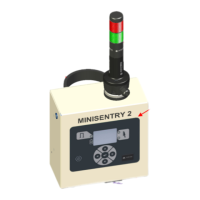USE MANUAL
MINISENTRY-2
107911_D User manual MINISENTRY-2_En.docx
MIRION TECHNOLOGIES (Canberra) S.A.S, BP249, ZI de Vauzelles, 3760
2. Press the key to access the main menu.
Note: The LEDs of Interfaces 1 and 2 light up in the red, green and blue color cycle and
return to the previous state
13 PORTAL PROBE CALIBRATION
The MiniSentry-2 Portable Portal Monitor is a gamma sensitive instrument. It should be set up (plateau
curves and detector checks) with a gamma source. The most common and recommended source is
137
Cs which provides the 660 keV gamma rays that are used for normal calibration. This radioactive
source is available from several manufacturers and quantities up to 185 kBq (5 μCi) are considered
“exempt” by the United States Nuclear Regulatory Commission (NRC) and most state regulations,
meaning that no radioactive materials license is needed to possess and use these sources. “Exempt”
quantities may be different for your particular country—please check with your local regulatory body.
The sensitivity of the MiniSentry-2 meets the FEMA requirements of 37 kBq (1 μCi) of
137
Cs passing
midway through the width of the portal at any point 15 cm (6 inches) above the portal base and 15 cm
(6 inches) below the upper inside edge of the portal frame. This makes a 37 kBq (1 μCi)
137
Cs source
very useful for everyday operational check.
Note: One should take into consideration the radioactive decay of the source when determining its
current activity (T½ ≈ 30.1 years for
137
Cs).
While a 37 kBq (1 μCi) source can be used for a quick operational check, a 185 kBq (5 μCi) source is
ideal for plateau collection, for it exposes both detectors to an elevated field providing sufficient counts
for good statistical measurements.
These sources can be kept in the MiniSentry-2 case with no danger to the instrument or the people
around it. However, since the MiniSentry-2 is very sensitive, the source(s) should not be located near
(within 3 m or 10 feet of) the instrument while it is being used to avoid artificially raising the background
radiation level.
The calibration must be performed using a PC connected to the USB plug (see § Erreur ! Source du
renvoi introuvable.) and with Canberra Smart Probe Software (CSPS).
13.1 HIGH VOLTAGE
The high voltage is typically set to the value indicated by the maximum FOM value calculated in the
plateau process. The value is typically between 900 and 1100 V. High voltage settings greater than
1200 V will not usually provide any added benefit and will shorten the lifespan of the detector. The high
voltage is continuously measured by the MiniSentry-2. The high voltage measurement is calibrated at
the factory and while it is good practice to confirm that the high voltage set matched the actual high
voltage with a plus or minus 10 V tolerance during the annual calibration, the scintillation detectors
function well over a wide range of high voltage settings with only minimal changes in sensitivity with
variations of the high voltage.
Note: Detector pairs are matched at the factory to provide optimal performance.

